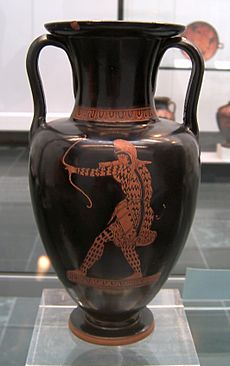Nolan amphora facts for kids
A Nolan amphora is a special kind of ancient pot. It's a type of amphora jar, which was a common container in ancient Greece and Rome. Nolan amphorae have a neck that is longer and thinner than other amphorae. They also have ribbed handles that look like straps, joining the pot near the bottom of the neck.
These pots are named after Nola, a place in Italy. Many of these unique vessels have been found there by archaeologists.
How Nolan Amphorae Began
The special shape and style of the Nolan amphora likely came from two older types of pots. These were made in Athens, a city in ancient Greece. They were called black-figure panel amphorae and red-bodied amphorae.
Black-figure pottery was a style where artists painted figures in black on a red clay pot. Red-figure pottery was the opposite: the background was painted black, and the figures were left in the natural red color of the clay.
Experts believe the black-figure panel amphora is the closest ancestor to the Nolan amphora. This is because it had a long neck, like the red-bodied amphora, and was also smaller, like the Nolan amphora. However, Nolan pots do not always have the decorative palmette patterns often seen on black-figure panel amphorae.
Both black-figure and red-figure neck amphorae were first made in Athens. The Nolan amphorae almost always feature red-figure designs. This style spread across Greece, Italy, and later the Roman Empire. This happened through trade with Greek artists, especially those from Athens. Some of the earliest Nolan vases were made specifically for trading in Etruscan markets. The Etruscans were an ancient people who lived in what is now Italy.
Gallery
See also
 In Spanish: Ánfora de Nola para niños
In Spanish: Ánfora de Nola para niños






